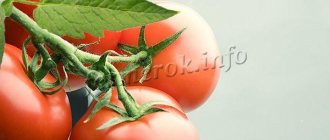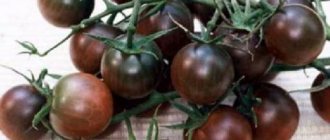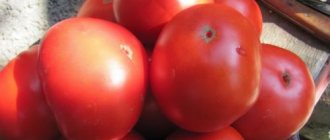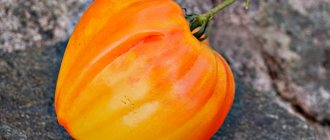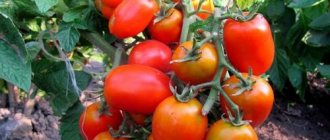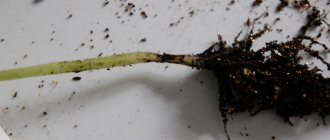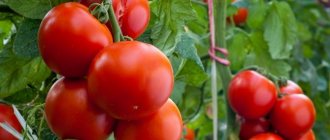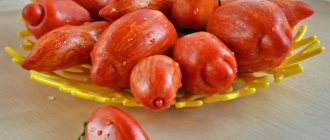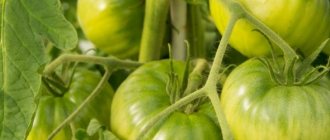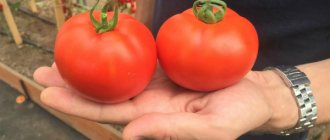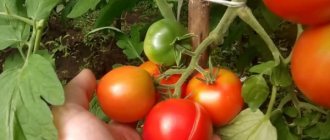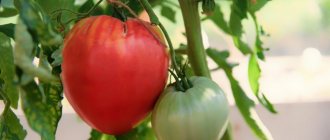Productivity
The Nastenka variety enters the fruiting phase early - the first tomatoes can be harvested within 85...105 days after emergence. The first fruit cluster is formed after the 10th leaf; over the entire season the bush will develop 12 such clusters.
There are many flowers on one plant, so to increase the yield, fruits that are not yet fully ripe are removed from it (at the stage of blanzhe ripeness, when the tomatoes have not yet turned crimson, but have already turned white). Nastenka gives away the harvest quite unanimously.
In 1 m2 of planting you can harvest up to 12 kg of sweet tomatoes. Basically, such a high yield is observed when Nastenka is grown in greenhouse conditions. In open ground this figure drops to 4...8 kg/m2. Thus, when planting Nastenka in open beds, gardeners collect 1...2 kg of tomatoes per bush.
Pros and cons of the Nastenka tomato
The Nastenka variety is liked by many gardeners. First of all, for combining early ripening with the sweetness of the fruit. Not all early varieties can boast of having a decent level of sugars in the fruits - most of them generally have an unexpressed or sour taste, which cannot be said about the Nastenka fruits.
In addition, we can highlight a number of other advantages of this variety:
- high commercial quality of fruits;
- versatility of use;
- disease resistance;
- resistance to prolonged cold snaps and temperature changes;
- stable average yield in open ground;
- high yield in the greenhouse;
- compact structure of the bushes, allowing you to save space on the site.
Among the disadvantages of the Nastenka tomato variety, we can only note that it is somewhat demanding in care. For high yields, bushes need to be provided with timely watering and fertilizing.
Care
Care procedures include watering, loosening and fertilizing. Watering should be done with warm water and in moderation. It should be installed only at the moment when the soil begins to slowly dry out. The ideal watering interval is 3-4 days. Loosening the soil is carried out so that the root system receives the necessary amount of nutrients and air. They are necessary for proper root formation.
What this variety is demanding about is feeding. It is best to use minerals that have a beneficial effect on plant growth and the taste of the fruit. It is for this reason that it is advisable to use phosphorus and potassium substances. It is better to apply them every 10 days and only after installing irrigation. This will allow the substances to be better absorbed into the soil.
Features of cultivation
The Nastenka variety is grown in seedlings using standard technology. By the time of transplantation to a permanent location, the seedlings should be about 60 days old.
Standard tomatoes allow you to save space on the site: the root system of the plants is small, their growth is low, so the feeding area is minimal. 4 plants can be placed per 1 m2.
In this case, you can use various planting patterns, for example, two-line or checkerboard.
- In the first case, it is recommended to maintain a distance of 30...35 cm between seedlings in a row with row spacing of 50...60 cm.
- In the second case, seedlings are planted keeping a distance of 50 cm between them.
The bushes practically do not need shaping. Stepchildren are promptly removed under the first flower brush. There is no need to form the top part. A garter to a support may only be necessary if there is heavy fruiting - in this case, the bushes may collapse under the weight of the fruit.
Tomato Nastenka formation with moderate pinching - video
To increase the number of fruits, it is necessary to water the Nastenka bushes in a timely manner. They especially need high-quality watering during fruiting. Dry conditions have a negative impact on crop yields. Of course, waterlogging of the soil due to excessive watering is also unacceptable.
During fruiting, tomatoes are watered once every 3…4 days, depending on weather conditions. To prevent moisture from quickly evaporating from the soil surface, it is recommended to mulch the beds after planting.
So, throughout the entire season, Nastenka needs complex feeding, the composition of which depends on the phase of development. So, for example, the first fertilizing after planting seedlings in a permanent place is carried out within 10...14 days, and it should include nitrogen. It is this element that will accelerate the growth of green mass.
Then fertilizing can be repeated after 10...14 days.
- In the budding phase, the amount of nitrogen in the fertilizer should decrease, and phosphorus and potassium will occupy the predominant part.
- We must not forget about adding boron during the flowering of bushes - this microelement is very important.
- During fruiting, fertilizing containing a large amount of potassium is also necessary - it is this element that is responsible for the filling of fruits and their taste characteristics.
In addition to watering and fertilizing, it is necessary to loosen the soil, weeding and hilling, which helps prevent exposure of the root system after watering.
Characteristics of a semi-determinate plant
The word determinate means limited in growth. Those who grew the Nastenka variety know that as soon as a flower ovary appears at the end of the stem, it stops growing. Therefore, the strongest shoot, located below the central shoot, begins to develop further.
You can recognize a semi-determinate tomato by:
- for seedlings - their cotyledonous knee straightens out and is no more than one or three centimeters in length;
- the formation of the first flower cluster - it appears after the seventh - eighth true leaf;
- laying flower clusters in adult tomatoes - two to three leaves between the clusters;
- restriction of growth after the formation of ten or twelve brushes.
Since Nastena is a standard type of vegetable plant, the thickened central stem does not need a garter. It stands perfectly straight without bending under the weight of the fruit.
Pros, cons of determinant
From the characteristics and description of the Nastenka variety, positive points can be highlighted:
See also
Description of the Golden Canary tomato variety and its characteristicsRead
- Due to the frequency of flower clusters, tomatoes ripen faster.
- The number of fruits on one bush is greater, hence the yield is higher.
- The pink fruits ripen together, since the clusters are tied at the same time.
The disadvantages of a semi-determinate variety include:
- predisposition to diseases;
- mandatory work on applying mineral fertilizers;
- pinching a plant due to the bush being overloaded with stems and fruits.
All the disadvantages of the variety are related to the requirements for tomato care.
Reviews from gardeners who planted
The Nastenka tomato appeared on store shelves quite a long time ago, so many Russian gardeners managed to test it on their plots. On the forums you can find comments and reviews from gardeners about Nastenka tomatoes, reflecting the results of growing this variety in different parts of the country.
Tomato: “The Nastenka variety is one of my pink favorites. Fruitful, tasty and sweet.”
anasst2010:
“2013 was an extremely bad year for all vegetables – it rained constantly. The tomatoes ripened poorly, the bushes were sick, but this variety performed best of all. The bushes were simply strewn with tomatoes. And besides that, they’re also delicious.”
Leno4ek:
“Nastenka turned out to be not early at all. The taste wasn’t particularly impressive either, but tomatoes are great for drying because of their dense walls.”
tutsa:
“When planted in a greenhouse, Nastenka produced large fruits weighing 200...300 g. Used for salads and tomato juice. The fruits have a dense consistency, do not crack, and are stored for a long time. The bushes have grown to a height of 90 cm.”
Miroslava:
“I wasn’t very impressed with the variety. The seedlings were planted in open ground, the yield, in my opinion, is quite low. Although I liked the tomatoes. I'll try to repeat it next season, but in the greenhouse. Maybe more tomatoes will form there.”
Maria P.:
“Nastenka has become one of the most favorite greenhouse varieties: the bushes are small, easy to care for and harvest. I am satisfied with the yield; basically, we eat everything and distribute it to relatives. I collect seeds from fruits myself, so I don’t spend money on buying them.”
Mikhail Alexandrovich:
“I love testing different varieties on the site. I planted 3 Nastenka bushes in open ground and in a polycarbonate greenhouse. The yield was much higher in the greenhouse, although all the bushes were looked after equally well.”
Consumer properties of fruits
Nastenka is an early-ripening tomato variety; the first harvest can be expected 100-110 days after the seeds sprout. In central Russia, in cool years, ripening dates may be pushed back to the second half of summer. In a greenhouse, tomatoes can be harvested as early as early July.
The shape of the fruit is round, elongated vertically, reminiscent of the fruits of the Ox's heart, although smaller in size. The average weight of 1 tomato is 200-250 g, some specimens grow up to 300 g. Tomatoes are collected in simple clusters of 3-5 fruits. The size of the ovaries in the hand can vary significantly.
The skin is thin, not very durable. The base of the fruit may crack if there is excess moisture during ripening. This reduces the quality of the fruit, and in some cases leads to the loss of part of the harvest due to rotting. The color at biological ripeness is deep pink, unripe tomatoes are pale green, with a spot at the stalk. Sometimes greenish areas remain on the shoulder even when the Nastenka tomato is fully ripe.
The flesh is fleshy, grainy at the break, and its structure resembles that of Ox's heart or similar varieties. The core contains several small seed chambers, but most of them are located around the perimeter of the fruit. The taste is average. The taste, like many rose varieties, is biased towards sweet, but also has a slight piquant sourness. The aroma is moderate, characteristic of tomatoes.
Tomatoes of this type are good for preparing fresh salads and various snacks. The fleshy berry is suitable for slicing and as a filling for sandwiches. Tomato pucks are convenient for decorating baked dishes. Tomatoes can be used to add to caviar, frying for soups, sauces, where the lack of bright color of tomatoes does not matter.
For whole-fruit canning, you can choose only small, unripe fruits. Dense, not softened blanc tomatoes can be salted using the barrel method. It is best to process excess pink tomatoes into raw materials for juice and sauces.
Characteristics of tomato Irma and description of the variety Read
The pulp from Nastenka’s fleshy berries will be thick, and you won’t have to boil it for a long time. This product will better preserve vitamins and nutrients, and the sauces will be lighter in color than the standard version. Increased sugar content makes this product useful for children and is used in diets with limited acids.
